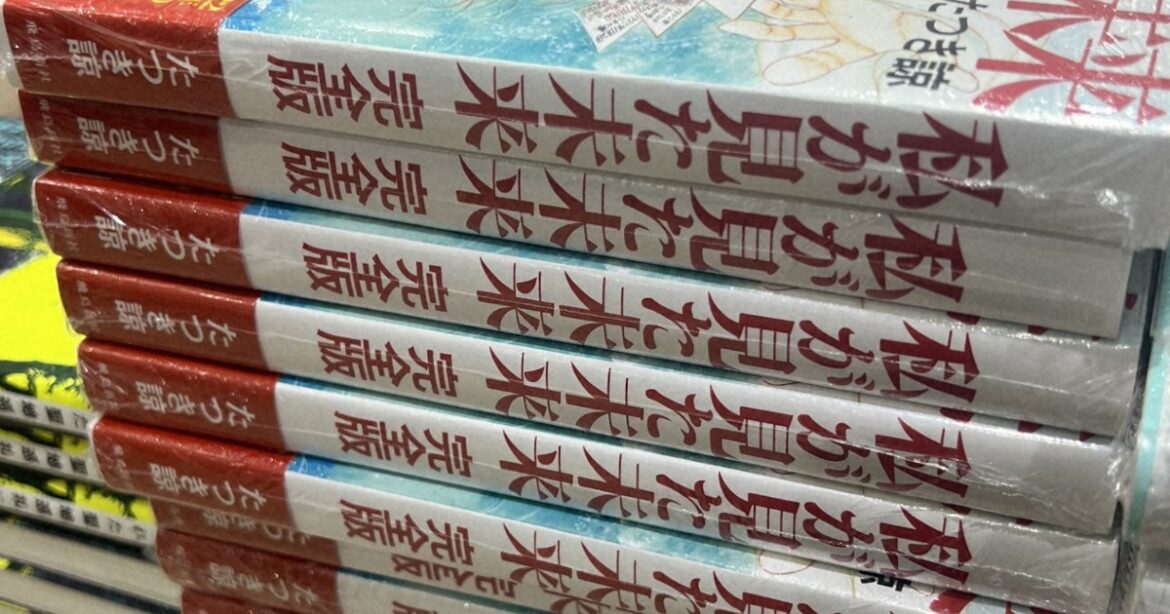
A stack of copies of “Watashi ga mita mirai” (The future I saw) by Ryo Tatsuki is seen at a bookstore in Tokyo in May 2025. (Mainichi/Ayane Matsuyama)
TOKYO — Prophecies of disaster written in a 1999 manga book, with no scientific backing, are affecting travel to Japan among Hong Kongers as word of the predictions spreads on social media.
Posts on social media and video sharing sites warning of major disasters striking Japan are talking about canceling their trips to the country. One source of the furor is a “complete edition” of the book “Watashi ga mita mirai” (The future I saw) by manga artist Ryo Tatsuki that was published by Asuka Shinsha in 2021. The author herself has called for calm when speaking with the Mainichi Shimbun.
Reduction of Japan-Hong Kong flights
In April, Hong Kong airline company Greater Bay Airlines announced that from May 12 through Oct. 25, it will reduce its Sendai service from four to three flights per week and its service to the western Japan city of Tokushima from three to two flights per week. The airline determined that demand was rapidly declining due to speculation that a major disaster was expected to hit Japan in July. U.S. President Donald Trump’s tariff policy has also made the economic situation more uncertain, leading them to decide on flight reductions.
A company official commented, “Interviews with customers revealed that the degree to which they believe in the information is quite high. In Hong Kong, many people believe in feng shui, and there may be some cultural differences. We did not want to see an increase in unprofitable flights, so we had no choice but to reduce the number.”
Were the 2011 Great East Japan disasters predicted?
Tatsuki’s book describes the author’s experiences of prophetic dreams, and the outer casing of the book reads, “The real disaster will come in July 2025.” The manga contains written passages such as, “I dreamed of a great disaster. The waters of the Pacific Ocean south of the Japanese archipelago will rise.”
Originally published in 1999 by a now-disbanded publisher and out of print, the book was reedited with new elements and published by Asuka Shinsha. According to the publisher, the book is currently a big hit, selling over 960,000 copies in total, and has also been published in Hong Kong and elsewhere.
One reason the original book attracted so much attention was for the warnings of a major disaster to strike in March 2011 printed on the front cover. Around 2020, the book was featured on TV shows and online video sites, and used copies began to be sold online for the equivalent of hundreds to thousands of dollars. Following those developments, Asuka Shinsha reportedly tapped Tatsuki to publish the new edition.
Free to interpret, but act appropriately: author
When asked about the trip cancellations and other effects the book has had, Tatsuki replied in writing, “I am merely taking it objectively.” She also commented, “The high level of interest everyone is showing is proof of growing awareness of disaster prevention, and I’m taking it as a positive thing. I hope that this interest will lead to safety measures and preparedness.”
At the same time, she said regarding information being shared about premonitions in dreams, “I believe that everyone should be free to make their own interpretation. However, I think it is important to not get overly swept up in the process and to act appropriately in consideration of expert opinion.”
The publisher reinforced Tatsuki’s message, stating, “The contents of this book published by our company are based on prophetic dreams the author had, and are not intended to stir up undue anxiety in any way. When it comes to disasters and other events, we believe it is important to respond carefully and appropriately based on expert advice.”
Satoru Kikuchi, a professor of cognitive psychology and head of the Shinshu University Disaster Mitigation and Prevention Center, calls for people to “fact-check information, stop and think.” He added, “Rather than refraining from going out or sightseeing, it is important to maintain a normal lifestyle while preparing for disasters on a daily basis.”
(Japanese original by Ayane Matsuyama, Digital News Group)


AloJapan.com